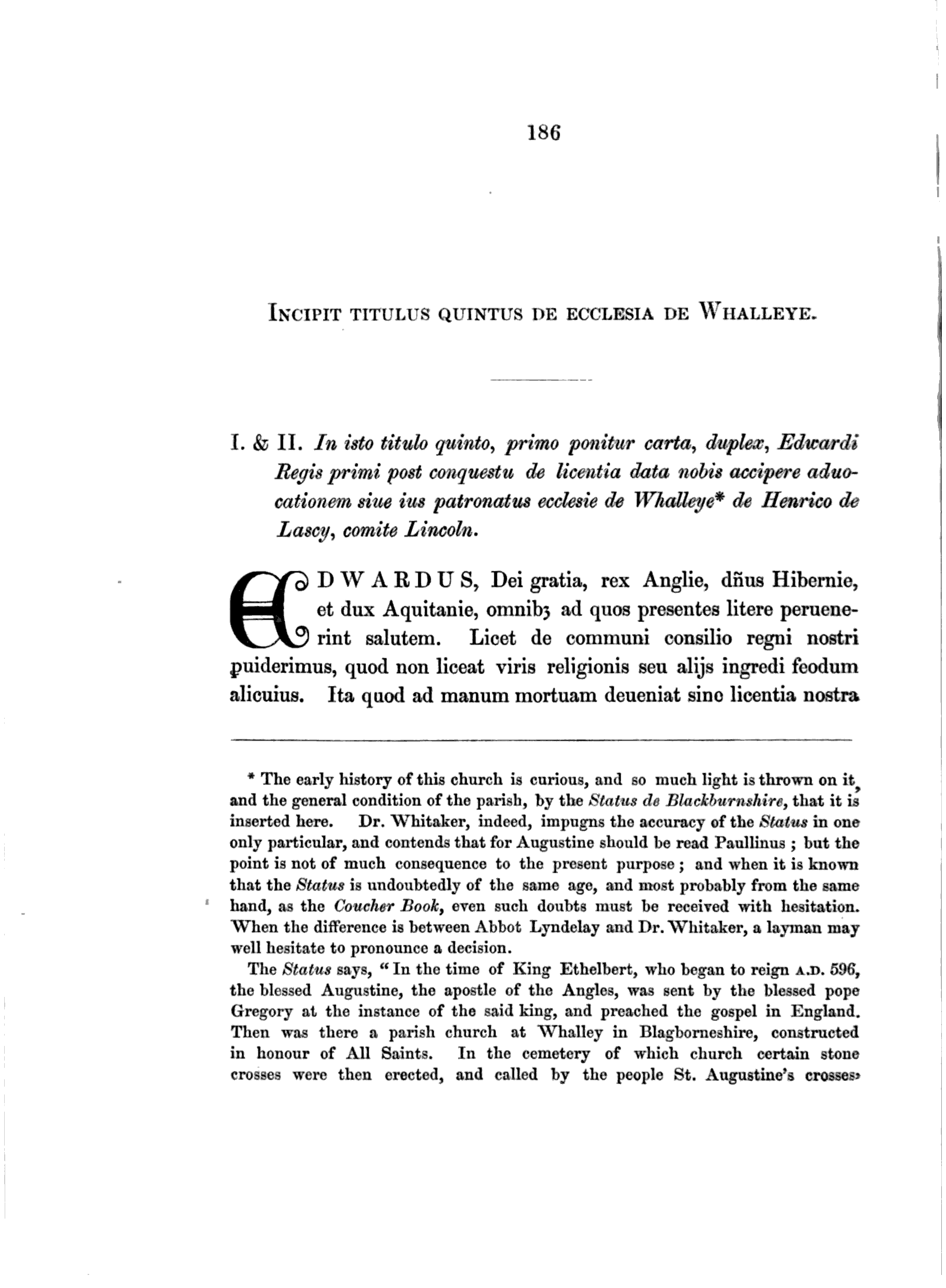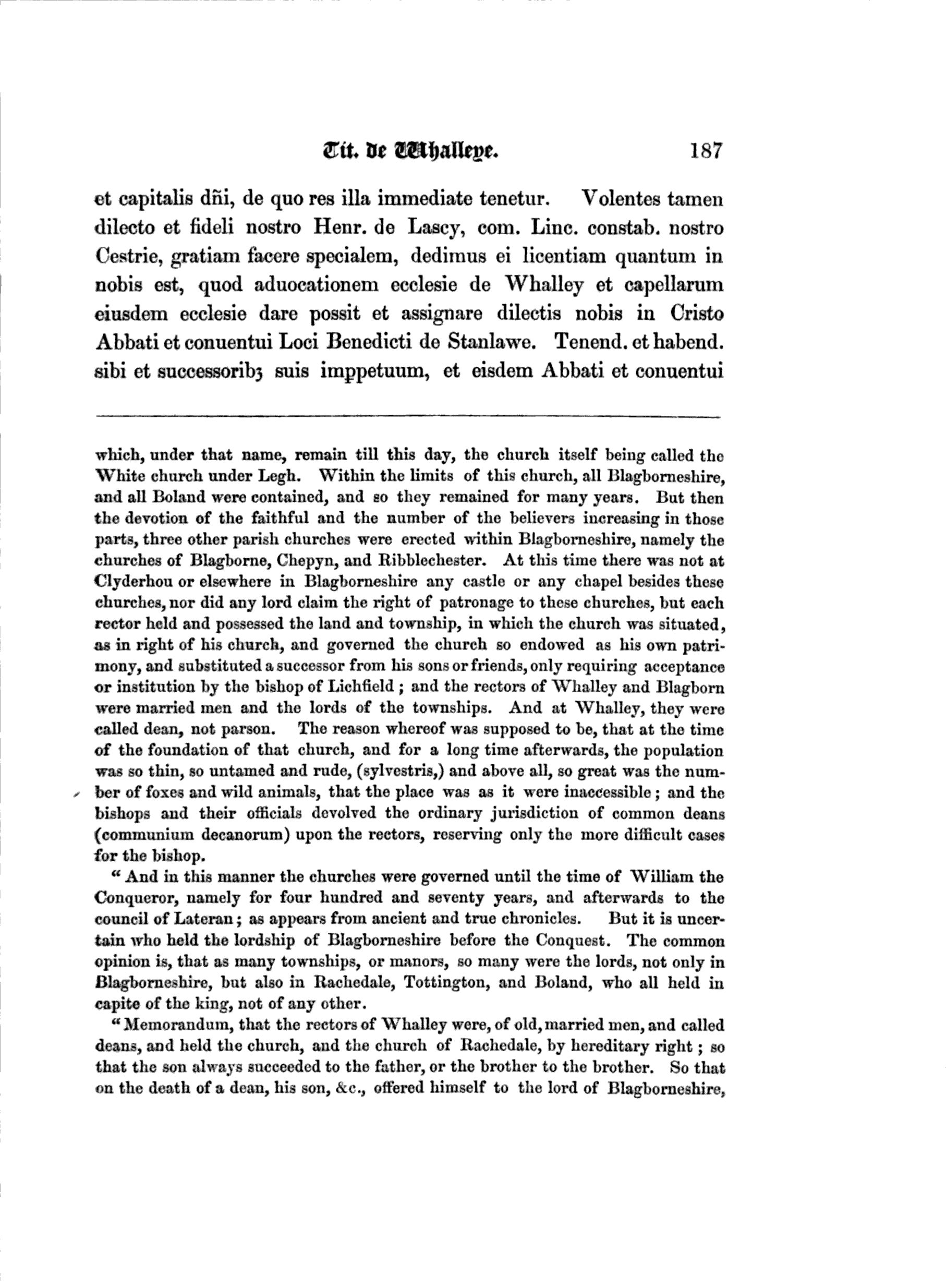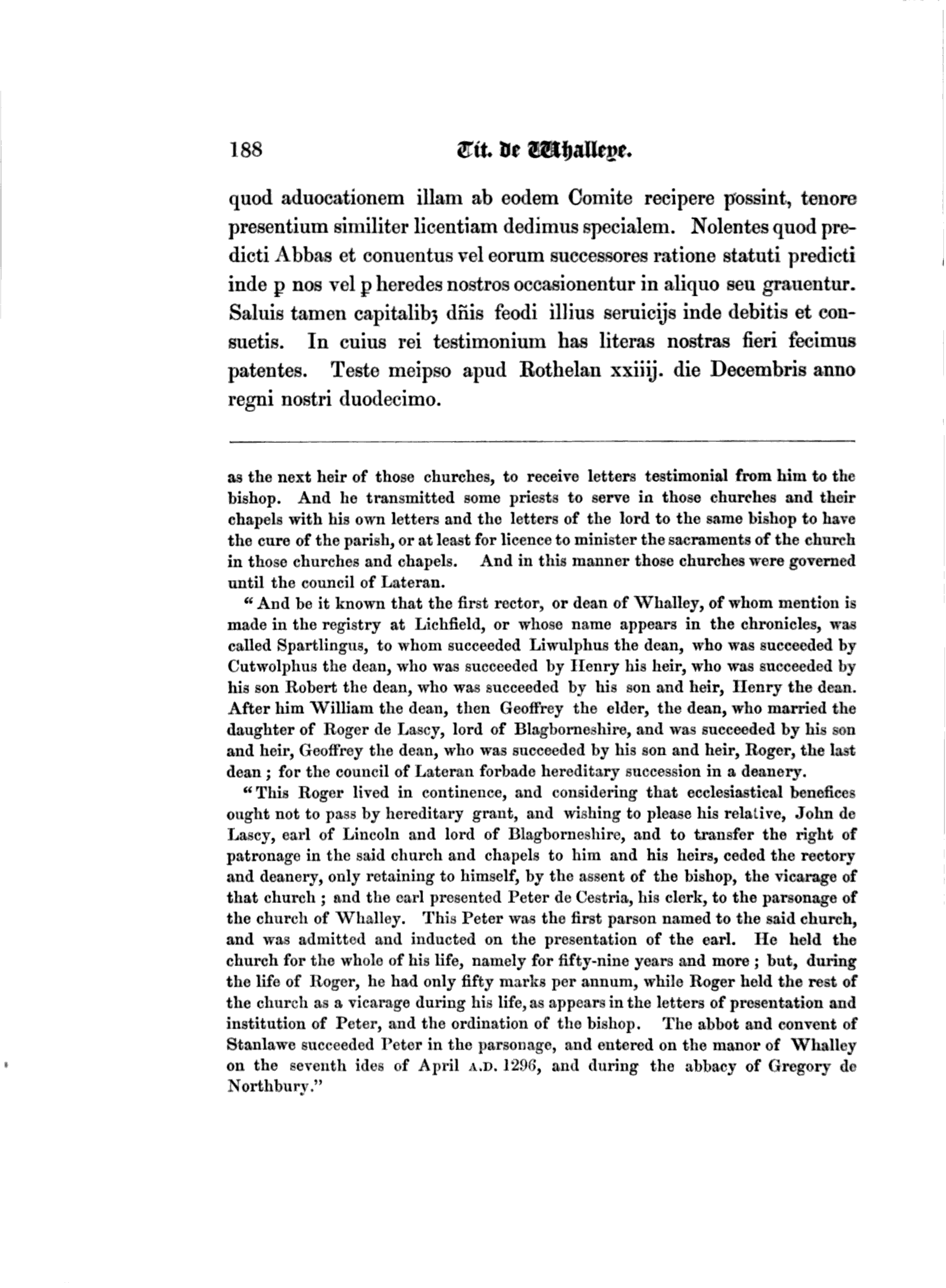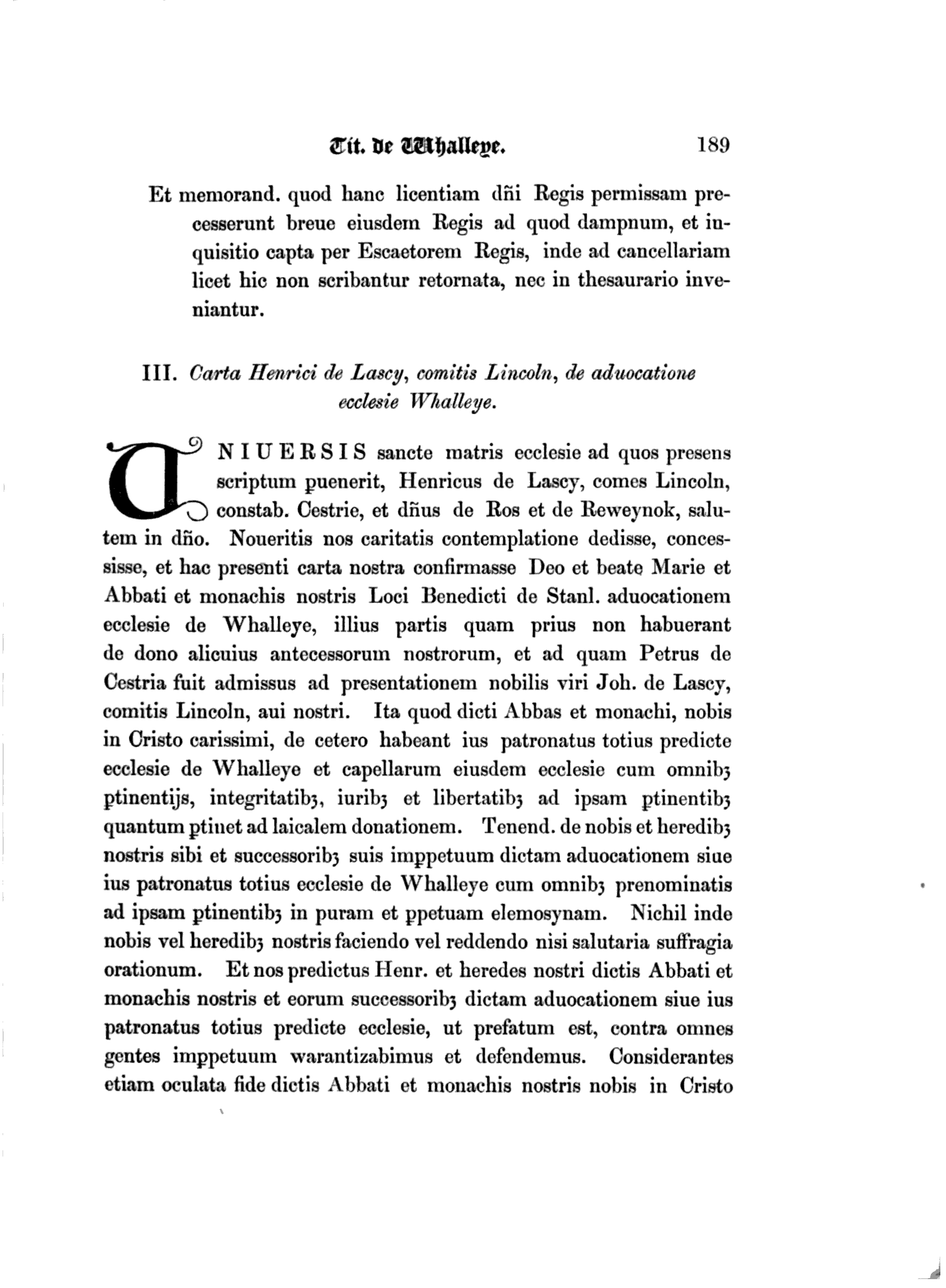The Coucher Book or Chartulary of Whalley Abbey Vol I., Nr. 194, S. 238





I. & II. In isto titulo quinto, primo ponitur carta, dúplex, Edwardi Regis primi post conquestu de licentia data nobis accipere aduo- cationem siue ius patronatus ecclesie <fe Whalleye* de Henrico de Lascy, comite Lincoln.
D W A R D U S, Dei gratia, rex Anglie, dñus Hibernie, et dux Aquitanie, omnib} ad quos presentes litere peruene- rint salutem. Licet de communi consilio regni nostri puiderimus, quod non liceat viris religionis seu alijs ingredi feodum alicuius. Ita quod ad manum mortuam deueniat sino licentia noatra
* The early history of this church is curious, and so much light is thrown on it^ and the general condition of the parish, by the Status de Blackburnshire, that it is inserted here. Dr. Whitaker, indeed, impugns the accuracy of the Status in one only particular, and contends that for Augustine should be read Faullinus ; but the point is not of much consequence to the present purpose; and when it is known that the Status is undoubtedly of the same ago, and most probably from the same hand, as the Coucher Hook, even such doubts must be received with hesitation. When the difference is between Abbot Lyndelay and Dr. Whitaker, a layman may well hesitate to pronounce a decision.
The Status says, "In the time of King Ethelbert, who began to reign A.D. 596, the blessed Augustine, the apostle of the Angles, was sent by the blessed pope Gregory at the instance of the said king, and preached the gospel in England. Then was there a parish church at Whalley in Blagborncshire, constructed in honour of All Saints. In the cemetery of which church certain stone crosses were then erected, and called by the people St. Augustine's crosses»
l^H^H noß^a<^V>o as.'oc«3o^
¿Г tt. ör ШЪлШ$ь 187
et capitalis dñi, de quo res illa immediate tenetur. Volentes tamen dilecto et fideli nostro Henr. de Lascy, com. Linc. constab. nostro Cestrie, gratiam facere specialem, dedimus ei licentiam quantum in nobis est, quod aduocationem ecclesie de Whalley et capellarum eiusdem ecclesie dare possit et assignare dilectis nobis in Cristo Abbati et conuentui Loci Benedicti de Stanlawe. Tenend. et habend. sibi et successorib} suis imppetuum, et eisdem Abbati et conuentui
which, under that name, remain till this day, the church itself being called the White church under Lcgh. Within the limits of this church, all Blagborneshire, and all Boland were contained, and so they remained for many years. But then the devotion of the faithful and the number of the believers increasing in those parts, three other parish churches were erected within Blagborneshire, namely the churches of Blagborne, Chepyn, and Ribblechester. At this time there was not at Clyderhou or elsewhere in Blagborneshire any castle or any chapel besides these churches, nor did any lord claim the right of patronage to these churches, but each rector held and possessed the land and township, in which the church was situated, as in right of his church, and governed the church so endowed as his own patri mony, and substituted a successor from his sons or friends, only requiring acceptance or institution by the bishop of Lichfield; and the rectors of Whalley and Blagborn were married men and the lords of the townships. And at Whalley, they were called dean, not parson. The reason whereof was supposed to be, that at the time of the foundation of that church, and for a long time afterwards, the population was so thin, so untamed and rude, (sylvestris,) and above all, so great was the num ber of foxes and wild animals, that the place was as it were inaccessible; and the bishops and their officials devolved the ordinary jurisdiction of common deans (communium decanorum) upon the rectors, reserving only the more difficult cases for the bishop.
"And in this manner the churches were governed until the time of William the Conqueror, namely for four hundred and seventy years, and afterwards to the council of Lateran; as appears from ancient and true chronicles. But it is uncer tain who held the lordship of Blagborneshire before the Conquest. The common opinion is, that as many townships, or manors, so many were the lords, not only in Blagborneshire, but also in Rachedale, Tottington, and Boland, who all held in capite of the king, not of any other.
"Memorandum, that the rectors of Whalley wore, of old, married men, and called deans, and held the church, and the church of Rachcdale, by hereditary right ; so that the son always succeeded to the father, or the brother to the brother. So that on the death of a dean, his son, &LC., offered himself to the lord of Blagborneshire,
188 int. oc
quod aduocationem illam ab codem Comite recipere p'ossint, teuore presentium similiter licentiam dedimus specialem. Nolentes quod pre- dicti Abbas et conuentus vel eorum successores ratione statuti predicti inde p nos vel p heredes nostros occasionentur in aliquo seu grauentur. Saluis tamen capitalib} dñis feodi illius seruicijs inde debitis et con- suetis. In cuius rei testimonium has literas nostras fieri fecimus patentes. Teste meipso apud Roth elan xxiiij. die Decembris anno regni nostri duodecimo.
as the next heir of those churches, to receive letters testimonial from him to the bishop. And ho transmitted some priests to serve in those churches and their chapels with his own letters and the letters of the lord to the same bishop to have the cure of the parish, or at least for licence to minister the sacraments of the church in those churches and chapels. And in this manner those churches were governed until the council of Lateran.
"And bo it known that the first rector, or dean of Whalley, of whom mention is made in the registry at Lichfield, or whose name appears in the chronicles, was called Spartlingus, to whom succeeded Liwulphus the dean, who was succeeded by C'utwolphus the dean, who was succeeded by Henry his heir, who was succeeded by his son Robert the dean, who was succeeded by his son and heir, Henry the dean. After him William the dean, then Geoffrey the elder, the dean, who married the daughter of Itogcr de Lasoy, lord of Blagbomcshire, and was succeeded by his son and heir, Geoffrey the dean, who was succeeded by his son and heir, Roger, the last dean; for the council of Lateran forbade hereditary succession in a deanery.
"This Roger lived in continence, and considering that ecelesiastical benefices ought not to pass by hereditary grant, and wishing to please his relative, John de Lasev, earl of Lincoln and lord of Blagborncshire, and to transfer the right of patronage in the said church and chapels to him and his heirs, ceded the rectory and deanery, only retaining to himself, by the assent of the bishop, the vicarage of that church ; and the earl presented Peter de Cestria, his clerk, to the parsonage of the church of Whalley. This Peter was the first parson named to the said church, and was admitted and inducted on the presentation of the earl. He held the church for the whole of his life, namely for fifty-nine years and more; but, during the life of Roger, he had only fifty marks per annum, while Roger held the rest of the chureh as a vicarage during his life, as appears in the letters of presentation and institution of Peter, and the ordination of the bishop. The abbot and convent of Stanlawc succeeded Peter in the parsonage, and entered on the manor of Whalley on the seventh ides of April A.D. 1296, and during the abbacy of Gregory de Northburv."
2Ttt. De aballege, 189
Et memorand. quod hanc licentiam dñi Regis permissam pre- cesserunt breue eiusdem Regis ad quod dampnum, et in- quisitio capta per Escaetorem Regis, inde ad cancellariam licet hic non scribantur retornata, nee in thesaurario inve- niantur.
Whalley Abbey II, ed. Hulton, 1847 (Google data) 194, in: Monasterium.net, URL </mom/WhalleyAbbeyII/12968806-4958-4ba0-8a03-27c6a36bd04e/charter>, accessed at 2024-05-02+02:00
The Charter already exists in the choosen Collection
Please wait copying Charter, dialog will close at success